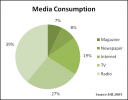 I guess we live in an age where everything starts with an ‘e’.
I guess we live in an age where everything starts with an ‘e’.
E-mail, e-learning, e-governance, e-Europe….
Commerce has entered this group of new concepts a while ago.
If you think of e-commerce, don’t lose sight of EDI, Electronic Data Interchange. Internet is the driver of growth of e-commerce if we consider former electronic networks besides the internet as part of it. It would make little sense to talk about revenues without considering the spending and the effort behind them, this is why we’ll also look at adspend figures around Europe in connection to internet consumption.
E-commerce: EDI + Internet, which one drives growth?
Even though EDI is getting old it is still very wide spread and it counts for a good share of a company’s transactions and revenues. I managed to put together a little data for me to analyse as an analyst in training that I am. I found EDI to be still something that should be kept in mind by both business people and by the gurus of the web as it has the potential of turning its share of transactions towards the web any day now. The numbers I’m talking about here are the percentages of revenue driven by e-commerce (EDI + internet) and then purely internet transactions.
 I focused on how Europe’s doing, assuring that the data I compare comes from either an apple orchard or an orange one and not both 😉
I focused on how Europe’s doing, assuring that the data I compare comes from either an apple orchard or an orange one and not both 😉
All e-commerce (internet + EDI) accounted in 2006 for 14% of all revenue for businesses in Germany, 8% in Spain, 18% in France and 18% in UK. Belgium was at 9% in 2005. E-commerce has seen an increase in most countries in Europe, ranging from 7,5% in Germany, 12,5% in the UK, to a staggering 166% in Spain.
Internet transactions accounted for 4% of a company’s revenue in Germany, 5% in Spain, 4% in France and 6% in the UK, in 2006 . Belgian companies got 3% of their revenue from internet operations last year. By digging deeper into the numbers we see Internet revenues increased from 2005 to 2006 from 33% in Germany, 50% in the UK to again an amazing 400% in Spain. In Belgium there has been a 50% growth of revenues generated by the internet from ’05 to ’06.
By further analysis we see that the growth in E-commerce is driven by the internet, while EDI is stagnating, and its place will eventually be taken by SOA. EDI still holds around 10% of a company’s revenue in Europe. This percentage will all become revenue generated through the web, in a matter of years as E-commerce will be defined by internet commerce, including SOA.
An important piece of the puzzle, is the fact that 80% (it’s the same all across Europe) of the internet generated revenue comes from B2B transactions, pretty much what EDI does, but through the web. EDI will eventually disappear leading to an even stronger growth for the internet channel. The latter will benefit from more attention and better integration. Here I’m talking about something like BI and WA put together in the same system and serving the same goal (vision + strategy).
Adspend vs Internet consumption
 From a different perspective, online shopping is increasing. It has reached 790€/shopper in a period of 6 month in 2006. The growth is visible in all countries. Take a look at eiaa.net for more data.
From a different perspective, online shopping is increasing. It has reached 790€/shopper in a period of 6 month in 2006. The growth is visible in all countries. Take a look at eiaa.net for more data.
Even if the revenues are still low when it comes to internet, keep in mind the fact that a discrepancy remains between adspends & media usage. In the UK the online adspend reaches 12% of the 17bn € overall adspend, in Germany it is 5% of 16bn, in Spain it comes up to merely 2% of 6,7bn. If in France the online adspend is a bit under 10% of the overall 10bn € spend, in Belgium it only comes up to 2% of the total 2,4bn€.
 In connection to other media, the internet is consumed at around 20% (in 2005 so greater today) in Belgium, yet the adspend is only at 2%. The difference between internet consumption and the adspend is at least 10% or higher for the rest of the European countries as well.
In connection to other media, the internet is consumed at around 20% (in 2005 so greater today) in Belgium, yet the adspend is only at 2%. The difference between internet consumption and the adspend is at least 10% or higher for the rest of the European countries as well.
The point I am getting to…
Add to that the fact that these e-commerce figures are direct sales and do not take into account direct or indirect influences Internet has on to offline channels. How many people surf on the car manufacturer’s website before pushing the dealers’ door?
Marketers have to pay more attention to the online channel as the web is alive again and strongly growing, and even more so in terms of online B2B. It’s up to us to measure it and help our clients redirect their strategy according to our common findings and discussions. The good news is that steering your companies’ strategy will not be as blind folded as before 😉
October 4, 2007 at 4:22 pm
Interesting post. I’ll have to do some more research on your statement that EDI will soon be taken over by SOA.